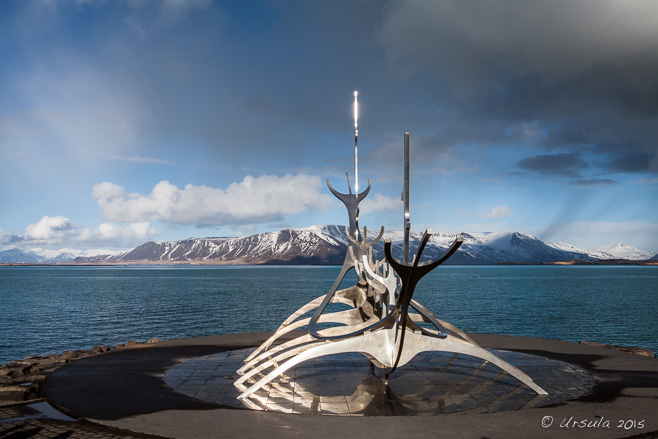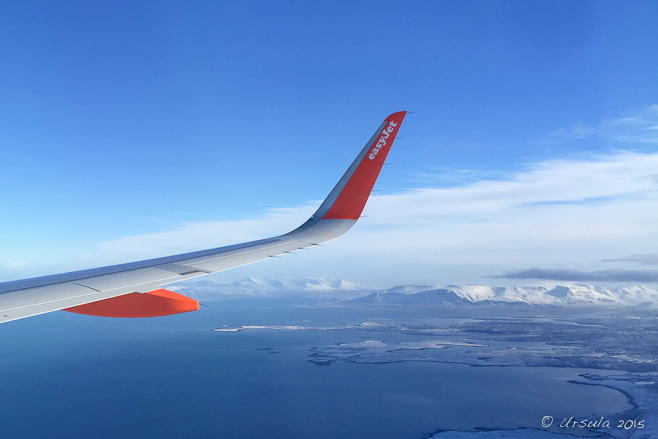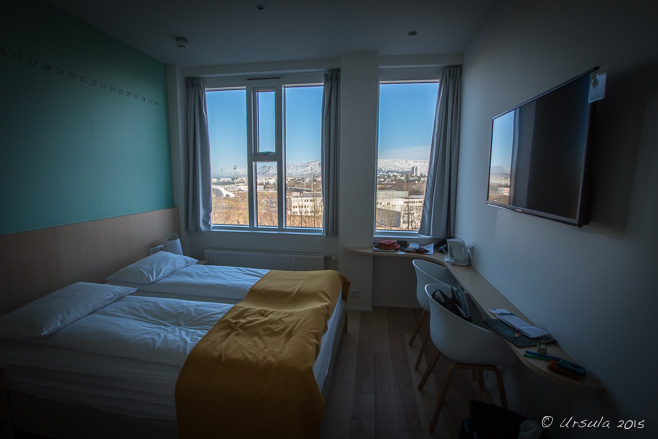
Sólfar – The Sun Voyager
What could be more Nordic than a dream-boat, facing out to sea? This striking stainless-steel work by Icelandic sculptor Jón Gunnar Árnason (1931 – 1989) overlooks the Sæbraut, the sea in the centre of Reykjavík, Iceland.
If you start typing “Reykjavík” into a Google search, the second thing that comes up – after “Reykjavík” itself – is “Reykjavík weather.”
No surprise, really. When I visited Iceland’s compact coastal capital city at the tail end of the nordic winter mid-March last year, he things that stood out to me most were the feeling f open landscape, the extraordinary light, and the constant threat of “weather”.
Reykjavík is Old Norse for “Smoke Cove” or “Bay of Smokes”, and was so named by Iceland’s first settler, the Norwegian Viking Ingolfur Arnarson, because of the white “smoke” rising from the hot springs. He must have been glad of of those hot springs after reputedly spending three years on the wild south-east coast where he and his fellow settlers had first landed.
But, even with the hot springs, winter can be grim. As one website puts it: “Winter (Nov/Dec/Jan/Feb/March): Especially during Nov-Feb, these are the darkest months and weather is generally terrible. Nothing open. Roads closed.”
Not exactly a glowing recommendation.
So, all things considered, we were rather lucky. Dark clouds loomed and threatened over our day around Reykjavik Harbour and the Old Town district, but the rains held off. The air was cold, but pleasant enough for walking, and the city’s public art almost made up for the lack of vegetation.

EasyJet over Iceland
On the approach to Keflavík International Airport, I get a sense of Iceland’s cold open space.
(iPhone6)

Spartan Accommodation
Our room – walking distance from downtown Reykjavík – is barely functional, but what a view!

The Harpa Concert Hall
The austere landscape only makes the architecture stand out more. (iPhone6)

Traffic Circle
The public art close to and along the Reykjavík waterfront brightens the winter streets.

“Obtusa”
The geometric “Obtusa”, created by Venezuelan Rafael Barrios, is built of flat sheets of brightly coloured metal. Installed in the traffic circle at the intersection of Katrínartún and Borgartún since 2013, the sculpture looks three dimensional, and changes in appearance as you walk or drive around it.

Höfði House
Built in 1909 as the residence of the French Consul of the time, the historic Höfði House now belongs to the city and is used for functions. The sculpture in Fjörutún Park represents the high-seat pillars that the first settler, Norwegian Ingolfur Arnarson, threw overboard when he sighted Iceland so that the gods might tell him where to establish his community.

Walking the Baby
The walkway along the Sæbraut, the Reykjavik Sea, is well used by tourists and locals alike.

Cairn on the Waterfront
Some of the ‘sculptures’ along the waterfront are quite informal. Mount Esja across the bay provides a stunning snowy backdrop.

Islandsvarden
A bronze abstract sculpture by Reykjavík-born artist Johann Eyfells evokes thoughts of volcanic rock.

Sólfar
The best-known and most striking water-front sculpture is the Sun Voyager designed by Jón Gunnar Árnason to commemorate the 200th anniversary of the city. The circle of granite slabs it stands on reflects the afternoon light.

Sun Voyager : Sólfar
In a 1987 interview, Jón Gunnar Árnason described his vision of the much-photographed sculpture: “The sun ship symbolizes the promise of new, undiscovered territory.”

Ingólfur Arnarson
The representation of Iceland’s first settler on the top of Arnarholl – a small hill near the harbour – by one of Iceland’s foremost sculptors, Einar Jónsson (1874 – 1954) has a mythical power to it.

Skúli Magnússon by Gudmundur Einarsson
Other artworks around town, like the 1953 bronze sculpture of Skúli Magnússon (1711 – 1794), one of Iceland’s most powerful forefathers, are larger-than-life, but more literal.

Jón Sigurðsson
Another bronze sculpture by Einar Jonsson sets Jón Sigurðsson (1811 – 1879), leader of the 19th century Icelandic independence movement, high on a stone plinth in the park opposite the Parliament House.

The Water Carrier
Renowned Icelandic sculptor Ásmundur Sveinsson (1893-1982) believed that art was for everyone. This piece is now in central Reykjavik, in spite of once being called “ugly and weird”. Many of his other figurative sculptures can be found in the garden outside the Ásmundur Sveinsson Sculpture Museum.

Reflections of Christmas
I love Christmas shops, and although Iceland lives up to its reputation of being extremely expensive, I couldn’t resist a few tree decorations.

Icelandic Colours
The beautiful woollen products, however, were well out of reach of my pocketbook! (iPhone6)

Dómkirkjan í Reykjavík
The elegantly simple Reykjavík Cathedral is an Evangelical Lutheran Church.

Dómkirkjan í Reykjaví
Every session of parliament – which is conducted in the Parliament House next door – begins with a mass here at the cathedral.

Afternoon on Lake Tjörnin

Lake Tjörnin
This small lake in central Reykjavík is home to many waterbirds, most notably the Whooper Swan (Cygnus cygnus).

Álft – Whooper Swan
These large birds breed in Iceland, but usually winter in England and Scotland, so the presence of so many here on Lake Tjörnin signals that winter is pretty much over.

“Single Gloves – Speed Dating”
Winter may be almost finished, but you still want both gloves – especially once the sun drops behind the Reykjavík buildings.
After a day well-spent and a rather pricy dinner (even simple meals in Reykjavík are expensive!), we managed to get back to our room with all our gloves still happily mated.

‘Till next time,
Happy Rambling!
Pictures: 17March2015




























.png)


[…] Smokes) was named for the white “smoke” rising from the hot springs in the area (see: Public Art, Reykjavík). Geysers are so prototypically Icelandic that the word itself came into English in […]
[…] Jet Nest In the cold morning light, we enjoyed another sculpture (see: Reykjavík): this one called The Jet Nest, by Magnús Tómasson. It shows a jet wing breaking out of an egg […]
[…] Jet NestIn the cold morning light, we enjoyed another sculpture (see: Reykjavík): this one called The Jet Nest, by Magnús Tómasson. It shows a jet wing breaking out of an egg […]